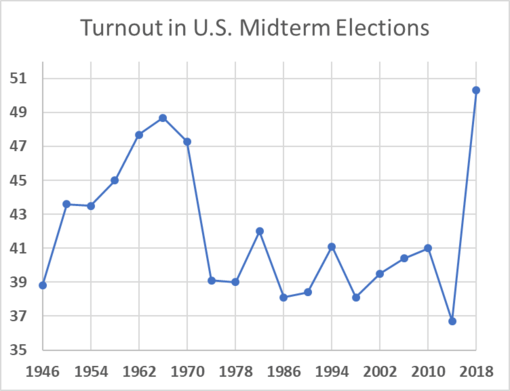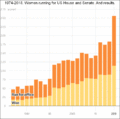2018 United States elections facts for kids
| ← 2017 2018 2019 → Midterm elections |
|
| Election day | November 6 |
|---|---|
| Incumbent president | Donald Trump (Republican) |
| Next Congress | 116th |
| Senate elections | |
| Overall control | Republican hold |
| Seats contested | 35 of 100 seats (33 seats of Class I +2 special elections) |
| Net seat change | Republican +2 |
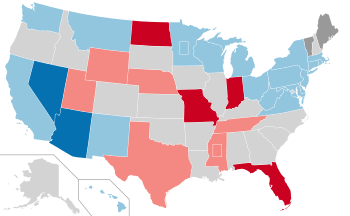 |
|
| 2018 Senate results (Minnesota and Mississippi each held two Senate elections) Democratic hold Republican hold Democratic gain Republican gain Independent hold |
|
| House elections | |
| Overall control | Democratic gain |
| Seats contested | All 435 voting seats +5 of 6 non-voting seats |
| Popular vote margin | Democratic +8.6% |
| Net seat change | Democratic +41 |
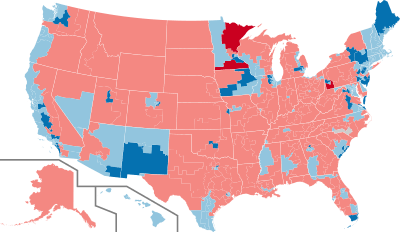 |
|
| 2018 House of Representatives results (territorial delegate races not shown) Democratic hold Republican hold Democratic gain Republican gain |
|
| Gubernatorial elections | |
| Seats contested | 39 (36 states, three territories) |
| Net seat change | Democratic +7 |
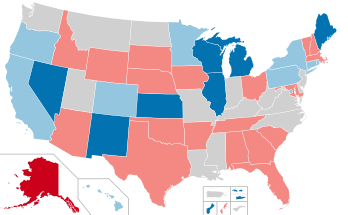 |
|
| 2018 gubernatorial election results
Democratic hold Republican hold Democratic gain Republican gain |
|
The 2018 United States elections were important elections held on Tuesday, November 6, 2018. These were midterm elections, which means they happened in the middle of a president's four-year term. At this time, Donald Trump from the Republican Party was the president.
During these elections, people voted for many different positions. They voted for 35 out of 100 seats in the United States Senate. They also voted for all 435 seats in the United States House of Representatives. Plus, there were elections for 39 governors in states and territories. Many other local and state positions were also decided.
The Democratic Party had a big win in the United States House of Representatives. They gained 41 seats and took control of the House. This meant the Republican Party no longer controlled both parts of the U.S. legislature. However, the Republican Party kept control of the United States Senate. They even gained two more seats there. In state elections, Democrats gained seven governorships. They also won control of at least 350 state legislative seats. This included six state legislative chambers.
These elections had a very high number of people voting. It was the highest voter turnout for midterm elections since 1914. Many people called the results for the House and state elections a "blue wave." This meant the Democratic Party (whose color is blue) had a lot of success.
Contents
Voter Turnout in 2018
On November 6, 2018, many people voted early. The United States Election Project reported that about 40 million people voted before election day. This set a new record for early voting.
Overall, 50.3 percent of people who could vote actually voted in 2018. This was a big jump from 2014, when only 36.7 percent voted. The 2018 elections had the most voters for a midterm election since the 1914 elections. This shows that many people were interested in the results.
Election Results Overview
The 2018 elections changed who controlled different parts of the government. Here's a quick look at what happened:
- House of Representatives: Before the elections, Republicans controlled the House. After the elections, Democrats gained control. They won 235 seats, while Republicans won 199.
- Senate: Republicans kept control of the Senate. They ended up with 53 seats, and Democrats had 47.
- Governors: Before the elections, Republicans held 33 governorships and Democrats held 16. After the elections, Democrats gained 7 governorships. Republicans held 27, and Democrats held 23.
These changes show how the power shifted between the two main political parties in the U.S.
How Many People Watched the Elections on TV
Many people watched the election results on television. Here's how many viewers different news channels had on election night.
|
Legend
|
Total TV Viewers (8 PM to 11 PM Eastern Time)
|
TV Viewers Aged 25 to 54 (8 PM to 11 PM Eastern Time)
|
Images for kids
See also
 In Spanish: Elecciones en Estados Unidos en 2018 para niños
In Spanish: Elecciones en Estados Unidos en 2018 para niños


